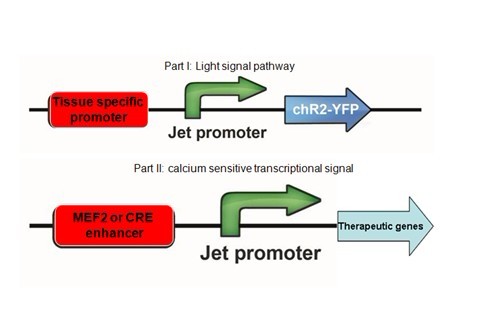Osteoarthritis (OA) is a chronical disease in which joint matrix is degraded and chondrocytes undergo disorderd and hypertrophic differentiation, symptoms including joint pain, tenderness and stiffness. The National Arthritis data Workgroup estimates the prevalence of OA in the United States as 26.9 million in 2005; this indicates a rise of nearly 30% over the course of the previous 10 years. Current treatments are focused on symptomatic relief but they lack efficacy to control the progression of this disease which is a leading cause of disability. Therefore, correct diagnosis and therapy is critical, since appropriate therapy influences not only joint function and quality of life, but can also prevent relevant end-organ damage.
We proposed two synthetic-biological approaches to OA, one with a eukaryotic genetic circuit and another prokayotic. Both circuits are composed of three systems: “Detector”, “Actuator” and “Supervisor”. As for Detector, we built tissue-specific promoters in the eukaryotic circuit, while inflammation factors are employed as signals of OA in the prokaryotic circuit. The same Actuator shared by two circuits generates proteins col2a1, which replenishes the degraded matrix, and oct4, which reverses the disordered differentiation. The eukaryotic Supervisor part has an original design in which a photo-sensitive cation channel crosstalks with certain cellular signaling pathways, resulting in the light-controlled expression of col2a1 and oct4; in the counterpart of prokaryotic circuit, both injected inducers and over-population lead the engineered bacteria to suicide, thus attenuating possible side effects.
2010 Team Wiki:http://2010.igem.org/Team:SJTU-BioX-Shanghai
